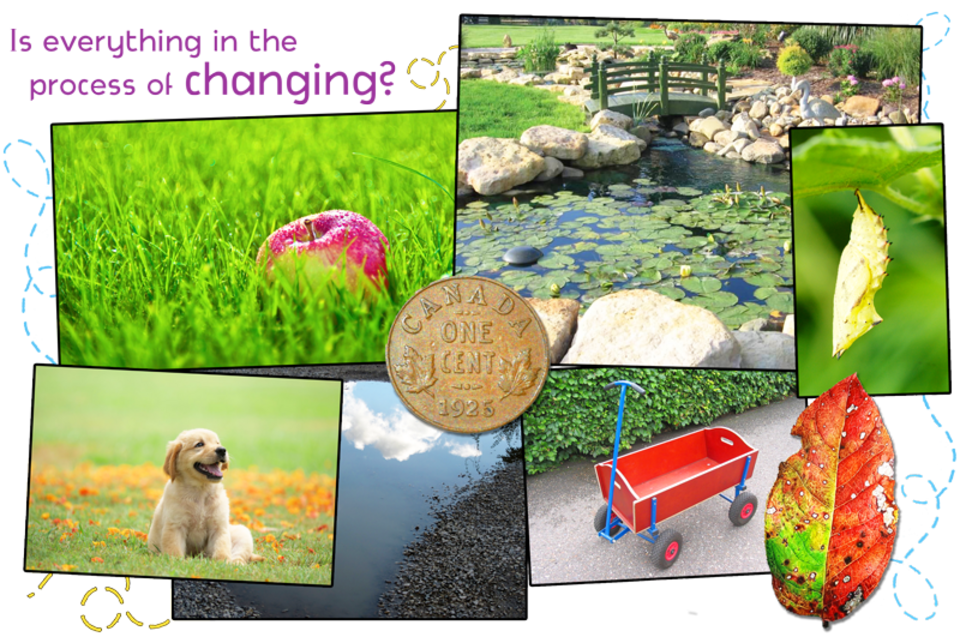
Snapshots of impermanence
| Objective: To share your creative thoughts on impermanence by capturing moments of change with snapshots! |
Duration: 15 to 45 minutes
Material:
- A camera to take pictures
- Sheets of paper
- Pencils, markers, eraser
- For the bonus: a potato, a kitchen knife, paint
Instructions:
Everything is always changing, nothing is ever permanent. This is the idea of impermanence, which can be found in Ancient Greek philosophy as well as in Buddhism. To better understand this idea, your mission in this activity will be to capture things as they change by taking snapshots—spontaneous photographs!...
...
- Decide where to shoot. Even though snapshots are spontaneous shots, start by thinking about where you would like to take pictures. Your mission will be to capture things as they change, so ask yourself where you're most likely to see something changing. This could be at home, of course, but also in a park, on a street, or even at school.
Take snapshots. Once you've chosen your location, walk around with your camera. Keep an eye out for what is changing. The change can be fast, like a balloon blowing up, but it can also be slow, like a new leaf growing on a branch. Don't hesitate to take dozens of pictures! Just know that if you take pictures of a person, you need their permission first.
- Variation: If you don't have a camera to take pictures with, you can also draw a snapshot of something changing, just like artists did for millennia before the invention of photography!
- Choose your best snapshots. It's time to choose! Most photographers take a lot more pictures than they need: it gives them the opportunity to select the best shots. In your case, choose at least three of your snapshots that best capture change as it is happening.
- Think about impermanence. Now think about these few questions: is everything really changing all the time? Is what is fleeting, i.e. rapidly changing, more valuable than what is durable, i.e. changing slowly or not at all? Can a photograph really make something changing permanent? Write your ideas on a piece of paper, then take a photo and send it with your three best snapshots, your first name and your age to ipcj@philo.umontreal.ca so we can share your position with other Philoquesters!
...
Bonus: Another way to resist impermanence is to leave your mark. Taken figuratively, this expression means to achieve something important, which will be remembered after your death. But what if we took the expression literally? To truly leave your mark, make a stamp with... a potato! Make sure to be careful or to ask an adult to help you. Cut a potato in half, draw the shape you want with a marker on one half, then cut around it with a knife so that the shape sticks out. Dip the shape in a little paint (or colour it in with felt tip pens) and you're done! You have a stamp that you can apply to a sheet of paper to leave your mark! Finally, think about the following questions: do you need to have achieved something extraordinary for your life to have been worth living? Is it important to be remembered after we die? Can it be dangerous to want to leave your mark? Why or why not? |

| Tricks for tots: Have you ever played the game "1, 2, 3 sunlight?" It’s very similar to “What’s the time Mr. Wolf?”. You have to move as fast as you can while a person with their back turned to you is counting out loud "1, 2, 3, sunlight," then freeze as soon as the person says "sunlight" and turns around. If they see you moving, you have lost and you have to go back to the starting line. If you reach the person counting, you win. To better understand the concept of impermanence, play a variation of this game! While the person is counting "1, 2, 3, impermanence," you have to change in some way as quickly as possible (e.g. by putting on new clothes, making a face, moving around), then as soon as the person finishes saying "impermanence" and turns around, you have to stop changing immediately! But... is it even possible to stop changing? For example, can you stop your nails and hair from growing or can you stop getting older? Is changing a choice? Why or why not? Maybe you can only control how you change but not whether you change... |
| Tips for teens: According to the Buddha, impermanence is an undeniable aspect of reality: everything that exists is always changing and is inevitably destined to disappear one day. Ignorance of this fundamental truth is, according to him, the main cause of human suffering. Indeed, a person who is unaware of the impermanence of everything will tend to become attached to things they believe to be permanent, like their youth, health, relationships with others or even their identity. But since these things change, that person will inevitably end up suffering when they realize that the things they were attached to no longer exist in the same way, or at all. The worst part is that instead of learning from this suffering, the person will tend to become attached to new things, which are bound to be impermanent as well. According to the Buddha, this cycle of attachment and suffering fuelled by the ignorance of impermanence characterizes the life of most human beings. The path of Buddhism is therefore an attempt to escape this cycle. What do you think about this? Do you think it's a mistake to become attached to people and things? Should we do anything to escape suffering? Would we be happier if we accepted that nothing is permanent? Why or why not? |
Share your creative reflections by sending them via email.
Include photos of your projects and notes of your thoughts, as well as your first name and your age!


